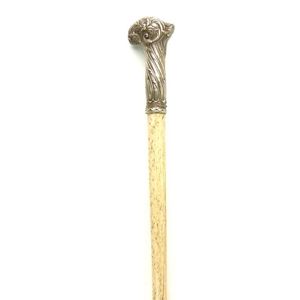Mariner's Walking Stick with Ivory Handle and Baleen Inlay
A fine 19th century mariner's walking stick the octagonal marine ivory handle inset with baleen diamonds, carved with a double-cord plait collar and surmounted by a Turk's knot finial, the tapering whalebone shaft carved with a wrythen twist, length 90 cm
You must be a subscriber, and be logged in to view price and dealer details.
Subscribe Now to view actual auction price for this item
When you subscribe, you have the option of setting the currency in which to display prices to $Au, $US, $NZ or Stg.
This item has been sold, and the description, image and price are for reference purposes only.
- Ivory - Ivory is a hard white material that comes from the tusks of elephants, mammoth, walrus and boar, or from the teeth of hippopotamus and whales. The ivory from the African elephant is the most prized source of ivory. Although the mammoth is extinct, tusks are still being unearthed in Russia and offered for sale.
Ivory has been used since the earliest times as a material for sculpture of small items, both in Europe and the east, principally China and Japan.
In Asia ivory has been carved for netsuke, seals, okimono, card cases, fan supports, animals and other figures and even as carved tusks.
In the last 200 years in Europe ivory has been used to carve figures, for elaborate tankards, snuff boxes, cane handles, embroidery and sewing accessories, in jewellery and as inlay on furniture. Its more practical uses include being used for billiard balls, buttons, and a veneers on the top of piano keys.
The use and trade of elephant ivory have become controversial because they have contributed to Due to the decline in elephant populations because of the trade in ivory, the Asian elephant was placed on Appendix One of the Convention on International Trade in Endangered Species (CITES), in 1975, and in January 1990, the African elephant was similarly listed. Under Appendix One, international trade in Asian or African elephant ivory between member countries is forbidden. Unlike trade in elephant tusks, trade in mammoth tusks is legal.
Since the invention of plastics, there have been many attempts to create an artificial ivory - Baleen - Baleen is the filter feeder system in a baleen whale, and these whales have several hundred plates of baleen with a hairy fringe on their upper jaw.
Baleen refers to the solid plate, and it is historically important as it was sought by whalers as a by-product of the whaling industry, who called it whalebone, though it is not made of bone at all, and used it for scrimshaw.
The earliest artefacts were made of baleen produced from Arctic whaling in the 17th century.
In the 19th century baleen was an important raw material, comparable to present-day plastics. Its thermoplastic nature and strength meant it could be used to make a wide variety of functional and decorative objects.
Sailors used baleen to make sewing boxes and other small containers and another common use was brush bristles; it was even used as runners on toboggans.
Baleen basketry was developed into a craft, with examples of simple baskets to complex woven ones, which could take months to complete.
Other shore-based uses included in corsets, buggy whips, umbrella ribs, canes, skirt hoops and especially as a cheaper substitute for ivory in carving. - Finial - An architectural decoration, found on the upper parts of of an object. On furniture they are usually found on pediments, canopies and shelf supports. On smaller ceramic or silver items, such as spoons, they may decorate the top of the item itself, or the lid or cover where they provide a useful handle for removal.
Finials have a variety of shapes and forms. They may be urn-shaped, baluster shaped round or spiral, but usually taper into an upper point. Many real life shapes may also be used as finials, such as pineapples, berries, pinecones, buds, lotus and acorns. Sometimes animals such as a lion are depicted, or fish and dolphins. - Wrythen - A spirally twisted ornamentation most commonly found on antique glass, silver, ceramics and furniture.
This item has been included into following indexes:
-
walking sticks and canes, material
- baleen 31
- ivory or ivory mounted 209
- whalebone 118
Visually similar items

A whalebone bone and silver walking cane, French Colonial, early 19th century. 90 cm long
Sold by
in
for
You can display prices in $Au, $US, $NZ or Stg.

A Malacca walking cane with carved ivory top, 19th century, 96 cm
Sold by
in
for
You can display prices in $Au, $US, $NZ or Stg.

A Chinese carved walking cane with conceale opium compartment, 19th century, 85 cm
Sold by
in
for
You can display prices in $Au, $US, $NZ or Stg.

A whalebone walking stick with carved whale's tooth fist handle with casuarina, cedar, baleen and horn spacers, 19th century, 88 cm long
Sold by
in
for
You can display prices in $Au, $US, $NZ or Stg.
